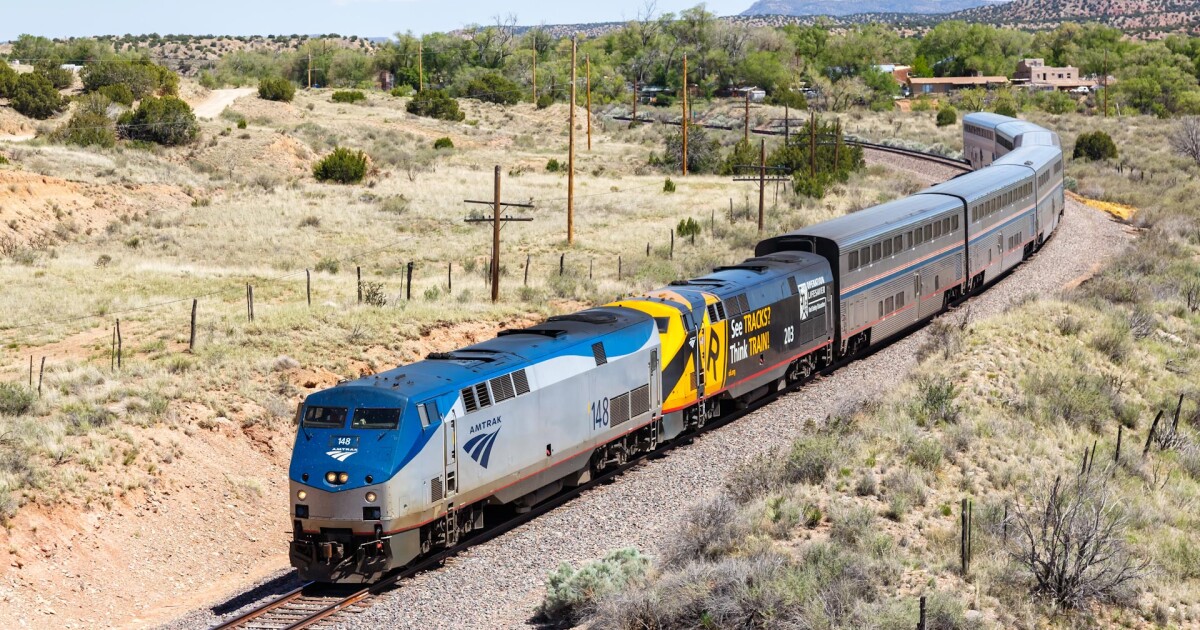Southwest states eye passenger trains amid uncertain federal support
7 min read

Adobe Stock
Several Southwest states are eying intercity or interstate passenger trains amid the region’s continuing population boom but their fate remains in the hand of a new administration whose support for rail remains uncertain.
A bullet train in Texas is the highest-profile of the various fledgling projects, and is expected to become once again a hot statehouse debate as lawmakers are set to consider bills filed both for and against high-speed rail.
Colorado, Arizona and Oklahoma are pushing their own passenger rail projects, some of which would be new and others that would mean extensions or expansions of cross-country Amtrak service.
The projects come as the Southwest is expected to see continued population growth in the coming decades. That’s especially true for the “Texas Triangle” — Dallas-Fort Worth, Houston, San Antonio — and parts of Arizona, Colorado and Utah, among others, the Federal Railroad Administration said in its Jan. 22 report on potential new long-distance Amtrak routes.
The
Some of the top recommendations feature routes across the Southwest. That includes boosting service on the Sunset Limited route between Los Angeles and New Orleans to daily from three times a week.
New federal dollars will be needed to implement any of the FRA’s recommendations or the projects under consideration by states. Under famously pro-train former President Joe Biden, a record-setting $66 billion for rail was allocated in the Infrastructure Investment and Jobs Act. That included $22 billion for Amtrak. The IIJA also featured new grant programs, which many southwestern states have applied for to help plan new routes.
“We were involved in helping get the big $66 billion in the IIJA,” said Andy Kunz, president and CEO of the US High Speed Rail Association. “We mostly focus on true high-speed rail, but that money is going to go to a lot of other projects, and we think that’s all necessary because we need a robust rail system all over the country and we don’t have one now.”
Newly confirmed Transportation Secretary Sean Duffy’s support for rail remains to be seen, said Sean Jeans-Gail, vice president of government affairs and policy at the Rail Passengers Association.
During his
Among passenger rail efforts in the southwest, a Texas bullet train —under discussion for more

Federal Railroad Administration
Lawmakers may also consider a bill that would ask voters to consider constitutional amendment requiring Texas Department of Transportation to use a chunk of its funds for transit project, which could include intercity passenger rail, said Peter LeCody, president of the nonprofit group Texas Rail Advocates.
“We have some very interesting bills for passenger rail, things we have not seen in the past,” LeCody said.
On the other side, lawmakers that oppose high-speed trains introduced
The bills aimed at the I-35 route to San Antonio are separate from the Dallas-Houston bullet train proposal, first pitched by private company Texas Central in 2009. With a price tag now as high as $33 billion, up from the original $10 billion, the Dallas to Houston bullet train plan stalled for years before winning new life from
The project may have an important ally in Sen. Ted Cruz, R-Texas, who is now chair of the Senate Committee on Commerce, Science and Transportation, in charge of the oversight of the next surface transportation bill, according to Jeans-Gail.
But the project also has opponents on Capitol Hill, including Texas Republican Rep. Jake Ellzey and colleagues who argue it’s a land grab and that Texas Central has violated the Foreign Agents Registration Act.
Ellzey, who has
“It was clear in our meeting that the only conceivable future for this project was to have Amtrak take it over from the near-defunct shell company known as Texas Central Railroad. It was equally clear that a large amount of federal funding would be required,” Ellzey said. “I informed Mr. Gardner that acquiring the land of the proposed route would involve forcibly evicting fourth and fifth-generation ranchers and farmers who have no interest in selling at any price. I also discussed how difficult the Texas Congressional delegation would make it to acquire any federal funding,” he said.
“This project simply has no future,” he added. “If some foolish bond buyers want to risk their fortunes on this boondoggle, caveat emptor!”
The prospect for a bullet train has also piqued the interest of the company that’s considered the frontrunner for high-speed efforts in the U.S.
Brightline, which owns
“They have definitely shown interest in Texas,” LeCody said. “Their antennas are up and they’re interested.”
Elsewhere in the southwest, Colorado is advancing a pair of passenger rail projects. The state last year passed
The bill also requires the Front Range Passenger Rail District to produce by March 1, 2025, a plan to begin rail service by Jan. 1, 2029.

Andy Kunz
The rail district was created by a 2021 state law that authorized it to levy taxes through ballot measures, issue bonds, and enter into a public-private partnership. Longer-term plans would connect Colorado to New Mexico and Wyoming. The district, which did not return a request for comment, may ask voters for an up to 0.8% sales and use tax to fund train service development and operation in 2026.
In Arizona, the state transportation department in December
Efforts to restore passenger rail service between Oklahoma City and Kansas by extending Amtrak’s Fort Worth-Oklahoma City Heartland Flyer route may also be inching forward.
“The full reconnection of this corridor, which was discontinued in 1979, will provide increased transportation choices and economic opportunity for rural and urban residents and businesses,” Martin Alvarez, KDOT’s rail project coordinator, said in a statement.
The big question mark for all the projects will be the level of support from the Trump administration and Congress.
“These projects are very difficult to delivery when you don’t have a federal and state leadership, like with highways where you always have both in place,” Kunz said. “It’s always a little bit of a struggle in the early days.”







